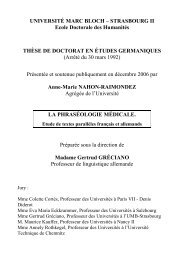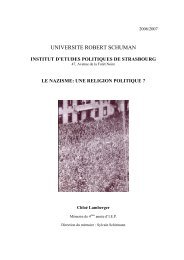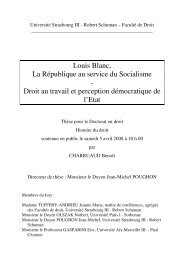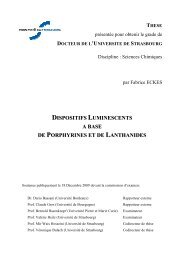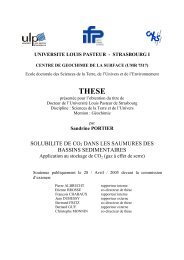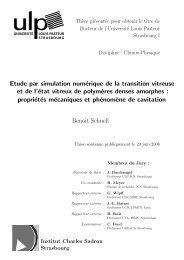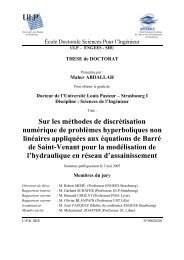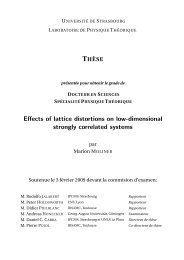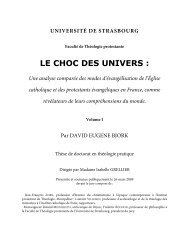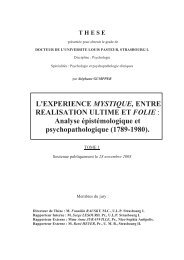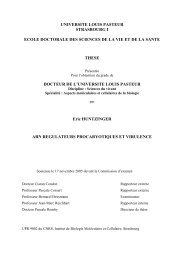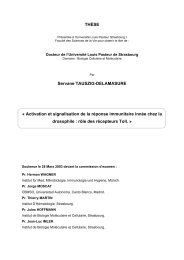Anthony KERMAGORET - THESES ET MEMOIRES DE L'UDS
Anthony KERMAGORET - THESES ET MEMOIRES DE L'UDS
Anthony KERMAGORET - THESES ET MEMOIRES DE L'UDS
Create successful ePaper yourself
Turn your PDF publications into a flip-book with our unique Google optimized e-Paper software.
Chapitre V<br />
spin system 1) and 3.06 and 3.23 ppm (ABX spin system 2) for 13 and 3.23 and 4.04 ppm<br />
(ABX spin system 1) and 3.49 and 3.57 ppm (ABX spin system 2) for 14 integrating for two<br />
protons each and corresponding to the signals of PCHAHB of the coordinated oxazoline and<br />
the free oxazoline. According to the HMBC NMR spectrum of 14, the signal at 3.23 and 4.04<br />
ppm correspond to the PCHAHB protons of the coordinated oxazoline moiety. In the 1 H NMR<br />
spectra of 13 and 14, the methyl protons appear as four singlets and the OCH2 protons form<br />
two distinct AB spin systems. The mutual cis-coordination of the phosphorus and the methyl<br />
group complex 13 is indicated by the doublet at 0.78 ppm with a 3 JPH of 3.6 Hz.<br />
In contrast to 13 and 14, the 13 C{ 1 H} NMR spectrum of 15 contains a singlet for the C atoms<br />
in α position to the methyls at 68.4 ppm, a singlet for the OCH2 carbon atoms at 83.4 ppm, a<br />
doublet for C=N at 174.7 ppm ( 2 JPC = 19.8 Hz) and a doublet for the PCH2 carbon atoms at<br />
29.6 ppm ( 1 JPC = 41.8 Hz). Its 1 H NMR spectrum shows an AB spin system for the OCH2<br />
protons at 4.44 and 4.57 ppm (JAB = 8.9 Hz) and an ABX spin system for the PCH2 protons at<br />
3.54 and 4.35 ppm. Its 31 P{ 1 H} NMR spectrum contains a singlet at 43.92 ppm. The IR<br />
spectrum of 15 presents an unique band for the C=N vibrations at 1613 cm -1 . According to the<br />
NMR and IR spectra, we conclude that ligand 3 coordinates the metal center in a tridentate<br />
fashion and that the molecule has a mirror plane passing through the P,Pd and the NMeCN<br />
atoms . The coordination of a MeCN molecule stabilizes the complex. 39<br />
2.5 Synthesis of the cobalt complexes<br />
In order to study the coordination of the tridentate ligands (NOPON Me2 ), 1-3 to a<br />
cobalt centre, complexes 16-19 have been synthesized, respectively (Scheme 6). The three<br />
complexes were obtained in high yield by reaction of the corresponding ligands with<br />
anhydrous CoCl2 in THF at room temperature.<br />
O<br />
N<br />
O<br />
Ph<br />
P<br />
16<br />
O<br />
Co Cl<br />
Cl<br />
N<br />
O<br />
N<br />
Cl<br />
Ph Ph<br />
P<br />
Co<br />
17<br />
Scheme 6. Co(II) complexes 16-19<br />
Cl<br />
N<br />
O<br />
P<br />
N Co N<br />
18 R = H<br />
19 R = Me<br />
O<br />
Cl Cl<br />
R R R<br />
R<br />
Complexes 16-19 proved to be paramagnetic in solution and their magnetic moments of 3.8,<br />
44, 46, 47<br />
4.1, 4.0 and 4.0 µB, respectively, were determined by the Evans method in CD2Cl2.<br />
These values are slightly lower than expected for high spin d 7 Co(II). 24, 29 Complex 17 was<br />
15



